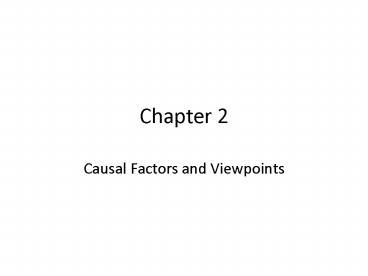Causal Factors and Viewpoints - PowerPoint PPT Presentation
1 / 25
Title:
Causal Factors and Viewpoints
Description:
the causal pattern of abnormal behavior. Necessary cause ... guarantees the occurrence of a disorder. Contributory cause ... Diathesis-stress models. Diathesis ... – PowerPoint PPT presentation
Number of Views:273
Avg rating:3.0/5.0
Title: Causal Factors and Viewpoints
1
Chapter 2
- Causal Factors and Viewpoints
2
Causes and Risk Factors
- Etiologythe causal pattern of abnormal behavior
- Necessary cause must exist for a disorder to
occur - Sufficient causeguarantees the occurrence of a
disorder - Contributory causeincreases the probability of
developing a disorder - Distal vs. Proximal factors-
- Reinforcing factors
3
Causes and Risk Factors
- Diathesis-stress models
- Diathesisrelatively distal necessary or
contributory cause that is not sufficient to
cause the disorder (i.e., genetics) - Stressthe response of an individual to demands
perceived as taxing - Protective factorsinfluences that modify a
persons response to environmental stressors,
making adverse consequences less likely - Resiliencethe ability to adapt successfully to
even very difficult circumstances
4
Biological Viewpoints and Biological Causal
Factors
- Neurotransmitter and hormonal imbalances in the
brain - Genetic vulnerabilities
- Temperament/other constitutional liabilities
- Brain dysfunction/neural plasticity
- Physical deprivation/disruption
5
The Neuron
Nucleus
Axon
Axon endings (buttons)
Synapse
Impulse
Cell body
Presynaptic neuron
Cell body
Axon
Neurotransmitters Chemical messengers released
into synapse
Postsynaptic neuron
Dendrites
6
The Synapse
7
Neurotransmitters
8
The Endocrine Glands
One particularly important set of interactions
occurs in the hypothalamic pituitary adrenal
cortical axis - Especially related to stress
9
Genetic Vulnerabilities
- Studies suggest that heredity is an
importantpredisposing causal factor for a number
ofdisorders - Abnormalities in the structure or number
ofchromosomes are associated with
malfunctionsand some disorders(e.g., Down
syndrome) - Genotypea persons total genetic endowment
- Phenotypethe observed structural and functional
characteristics
10
Genotype-Environment
- An individuals genotype may shape the
environment in the following ways - A passive effectresulting from the genetic
similarity ofparents and children - An evocative effectthe childs phenotype may
evoke particular kinds of reactions from the
social and physical environment - An active effectthe child seeks out or builds
an environment that is congenial
11
Methods for Studying Genetic Influences
- behavior genetics, the heritability of mental
disorders - The family history (pedigree) method
- The twin method
- The adoption method
- More recent methods include linkage analysis and
association studies
12
Temperament
- Temperament refers to a child's
- Reactivity
- Characteristic ways of self-regulation
- Our early temperament is thought to be the basis
from which our personality develops - i.e., genetic component to personality
13
Brain Dysfunction and Neural Plasticity
- Subtle deficiencies of brain function are
implicated in many mental disorders - It appears that genetic programs for brain
development are not as rigid and deterministic as
was once believed
14
Impact of the Biological Viewpoint
- Drugs can dramatically alter the severity and
course of certain mental disorders (e.g.,
schizophrenia) - What constitutes a mental disorder still rests on
subjective opinion - Also, psychological causes can be distinguished
from biological causes only prior to their entry
into the central nervous system
15
Psychosocial Viewpoints
- Psychodynamic
- Behavioral
- Cognitive-behavioral
- Humanistic
- Existential
16
Psychodynamic Perspectives
- Freud theorized that a persons behavior results
from the interaction of - The idthe source of instinctual drives
- The egowhich mediates between the demands of
the id and the realities of the external world - The superegothe outgrowth of internalizing the
taboos and moral values of society
17
Psychodynamic Perspectives
- The concept of anxiety is prominent in the
psychoanalytic viewpoint - The ego often deals with neurotic or moral
anxiety by using protective measures referred to
as ego-defense mechanisms - Please note psychological defense mechanisms
are not always irrational or maladaptive
18
(No Transcript)
19
Psychosexual Stages of Development
- Freud conceptualized five psychosexual stages of
development - Oral stage (02 yrs. old)
- Anal stage (23 yrs. old)
- Phallic stage (35/6 yrs. old)
- Oedipal period
- Latency stage (612 yrs. old)
- Genital stage (after puberty)
- Fixation at any one stage can shape adult
behaviors
20
The Behavioral Perspective
- Learning provides the central theme of the
behavioral approach - Classical conditioning learning by association
- Operant (instrumental) conditioning learning by
consequences i.e., reward and punishment
21
Observational Learning The Cognitive-Behavioral
Perspective
- Observational learning learning through
observation alone, without directly experiencing
an unconditioned stimulus - The cognitive-behavioral perspective focuses on
how thoughts and information processing can
become distorted and lead to maladaptive emotions
and behavior
22
The Cognitive-Behavioral Perspective
- Attributionsthe process of assigning causes to
things that happen - Attributional stylea characteristic way in
which an individual may tend to assign causes to
bad or good events
23
Psychosocial Causal Factors
- Psychosocial causal factors exemplifying the
range of factors that have been studied include - Early deprivation or trauma
- Inadequate parenting styles
- Marital discord and divorce
- Maladaptive peer relationships
24
Sociocultural Causal Factors
- Sociocultural factors associated with greater
risk for various disorders include - Low socioeconomic status
- Unemployment
- Being subjected to prejudice and discrimination
- Social change and uncertainty
25
Unresolved Issues
- None of the theories to date address the whole
spectrum of abnormality - Many psychologists have adopted an eclectic
approach, but this is not successful at a
theoretical level - The biopsychosocial perspective is the only
current attempt at a unified approach - The intersection of biological, psychological and
social factors.































